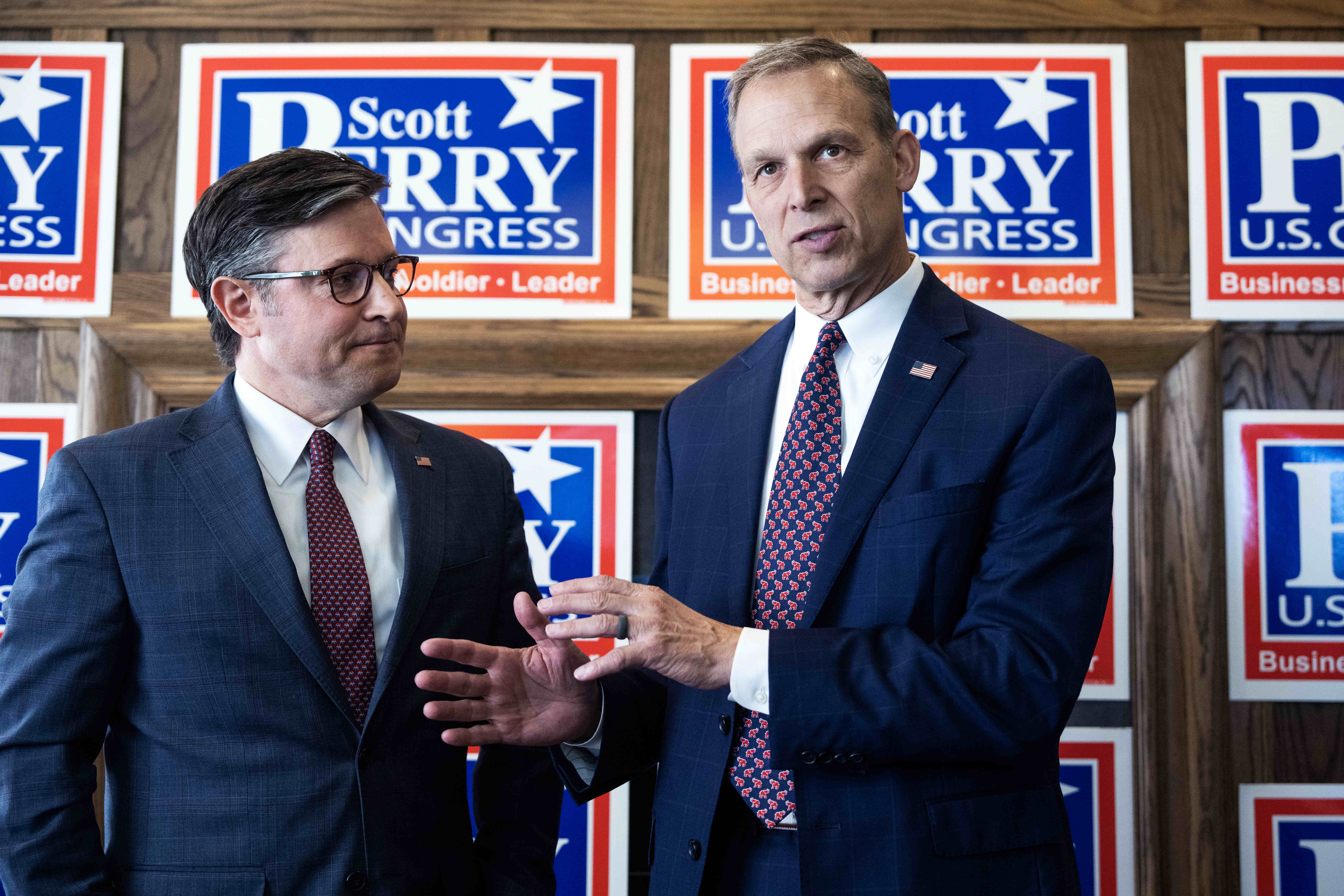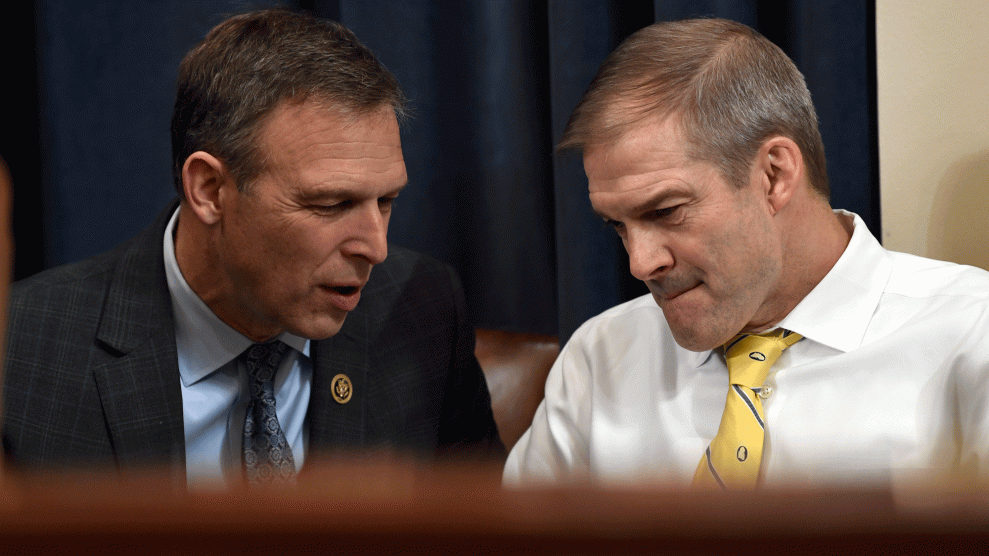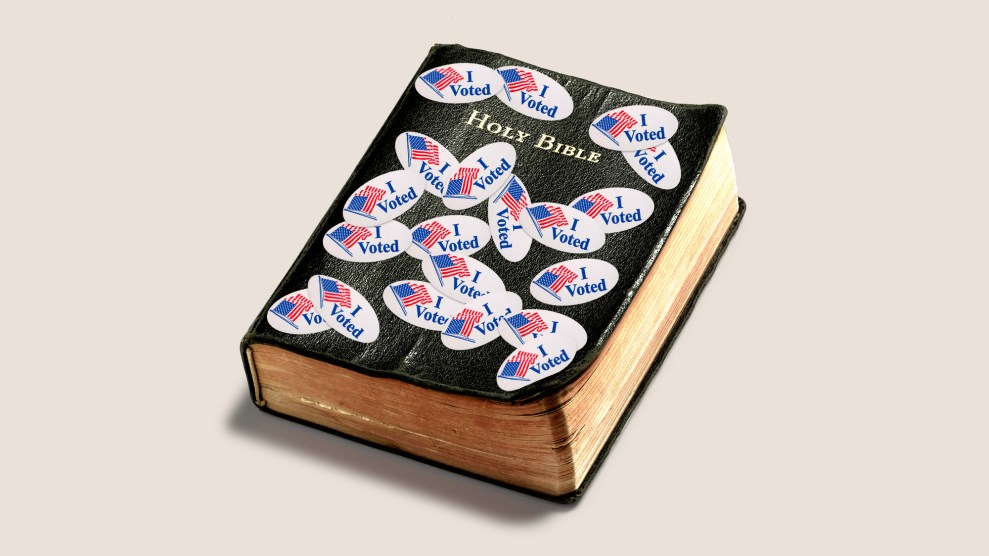
Janelle Stelson, Democratic candidate for Pennsylvania's 10th Congressional District, campaigns at the Broad Street Market in Harrisburg, Pa. Stelson is challenging Rep. Scott Perry (R-Pa.), for the seat.Tom Williams/CQ Roll Call/ZUMA
On a sunny Saturday afternoon in late October, Janelle Stelson, the Democratic candidate in Pennsylvania’s 10th Congressional District, entered Broad Street Market, a historic food hall in Harrisburg. “If I seem a little off,” she explained to me and another reporter, she had just come from a funeral. But now, grasping campaign signs in one hand, she was looking for breakfast among the Caribbean food stalls and Amish bakeries—and some voters.
Stelson made her way through the market with relentless friendliness, calling out “hey sister!” with her free hand outstretched. After a decades-long career as a local television anchor, she was a familiar face to many. As Stelson greeted passersby, Richard Utley, a retired government employee, told me that he’s “known Janelle a long time,” both from the evening news and from politics. “She’s got the best chance to beat Scott Perry,” he said.
Stelson has tried to make this race a referendum on Scott Perry, the firebrand conservative and six-term incumbent. She argues that Perry has lost sight of his constituents’ needs and come to exemplify the dysfunction in Congress. “The fact that Washington is broken resonates with everyone,” Stelson told me. “They want somebody who’s going to attend to their basic needs.”
In the market, she talked to voters about issues ranging from the rising cost of living to the shortage of reproductive healthcare providers. As Stelson nimbly navigated conversations, I could see how television journalism could provide transferable skills for electoral politics. As an anchor, she reported on these same issues dozens of times. Stelson had also covered this story before: the story of a political challenger making a case for ousting the incumbent. In her black funeral wear, Stelson was warm and effusive, doling out good sound bites. She expertly framed shots for the news photographer, pivoting so her campaign signs always faced the camera as she cooed over babies, hugged the elderly, and examined cookies.
Pennsylvania has emerged as the center of the political universe, as both presidential campaigns identified it as crucial to their Electoral College math. Doors are brimming with campaign literature, highways are crowded with competing billboards, and voters inundated with automated texts. In the state’s 10th district, Perry is facing his most difficult race yet, and one that may help to determine whether the GOP can hold onto its slim majority in Congress.
A retired Pennsylvania Army National Guard brigadier general, Perry made a name for himself as a Trump loyalist and former chair of the far-right House Freedom Caucus. As my colleague David Corn wrote in 2021, a Senate Judiciary Committee report revealed that Perry played a crucial role in former president Donald Trump’s effort to recruit Justice Department officials to investigate and overturn 2020 election results. Though the FBI briefly seized his cell phone, Perry has maintained his innocence and insisted that he was never under investigation. Still, his involvement has been costly—FEC reports show that Perry has spent at least $300,000 from his campaign donations on legal fees. Undeterred, Perry has continued to sow doubts about the 2020 election, and, during his only debate with Stelson, repeated false claims that the post office had illegally shredded mail-in ballots. In response, Stelson reiterated that mail-in voting is a “tried and true method.”
Perry also made national headlines as the Freedom Caucus made it increasingly difficult for the GOP to govern, threatening government shutdowns over spending bills and forcing Kevin McCarthy through 15 rounds of voting to become Speaker of the House—an ultimately short-lived tenure.

Perry was initially elected in 2013 to the solidly Republican 4th Congressional District. In 2018, Pennsylvania’s congressional districts were completely redrawn by the state Supreme Court, making Perry’s new 10th district much more competitive, and he was reelected by less than three points. In 2022, the district lines were redrawn once again, though much less dramatically, condensing the district around Harrisburg and York. Perry fended off Democratic challengers in 2020 and 2022, both by around seven points.
The district is fairly emblematic of the state at large: it is 70 percent white, with a median household income of $75,000 and about 35 percent of residents have at least a bachelor’s degree. Democrats say that the population is shifting in their favor. Cumberland and York counties, which are partially included in the district, are among the fastest growing counties in the state. “We’ve seen a lot of farmland convert to housing,” Matt Roan, chair of the Cumberland County Democratic Committee, said. “These people tend to be younger families with higher levels of education.”
Still, Republicans lead Democrats by almost 6 points in party registration, while 14 percent of registered voters are not affiliated with a political party. Trump won the district by 4 points in 2020, but Pennsylvania’s Democratic Gov. Josh Shapiro won the newly redrawn district by 12 points in 2022. That was likely in part because Shapiro’s opponent, Doug Mastriano, ran a chaotic and poorly funded campaign and, despite being a Trump stalwart, was largely abandoned by the national party. “I would not underestimate Scott Perry,” Berwood Yost, director of the Floyd Institute for Public Policy Analysis at Franklin & Marshall College, told me. “He is a polished political operator. He knows his district and knows how to talk to voters here.”
“I would not underestimate Scott Perry. He is a polished political operator. He knows his district and knows how to talk to voters here.”
Stelson has run a commanding race against Perry, having significantly outspent and outraised him. Campaign finance reports show that Stelson has raised almost $2.5 million this year to Perry’s $800,000. The Cook Political Report just shifted the race towards Democrats, calling it a “toss up,” and one recent poll had Stelson leading by nine points. National Republicans seem to be concerned. Earlier this month, House Speaker Mike Johnson appeared in the district to campaign on Perry’s behalf. The Congressional Leadership Fund, a Johnson-sponsored super-PAC, has spent more than $2 million on advertising for Perry ahead of Election Day, according to AdImpact. One of the group’s ads frames Stelson’s immigration stance as extreme, citing a candidate Q&A in which Stelson calls for fixing the asylum system and ensuring pathways to citizenship for Dreamers and “those who have been paying taxes for decades.” The ad’s voiceover declares, “Illegals get the invite, we foot the bill. That’s liberal Janelle Stelson.”
Perry is the only Freedom Caucus member from the Northeast, and he is among the most vulnerable of the hardline Republicans up for reelection this year. Despite this, Perry has largely doubled down on his positions. “Should I just go along with Washington, DC, as most of my other colleagues did, just to moderate myself?” Perry said to the Associated Press for a recent story on the race. “No, I’m going to do the right thing every single time I have the opportunity.”
If Perry can be beat, Democrats are convinced they finally have the right candidate to do so. Stelson spent 26 years as a broadcast journalist at WGAL, an NBC affiliate based in Lancaster, where she became a mainstay on televisions across the Susquehanna Valley. Throughout the campaign, Stelson has leaned on her journalism experience, arguing that it has given her a unique vantage point on the problems afflicting the region. It also gave her a big boost in recognition: voters knew her name and face long before she announced her candidacy. Stelson won a crowded Democratic primary by twenty points, beating a former US Marine and the Democrats’ 2022 candidate, despite concerns that she lives a few miles outside of district lines. (She has promised to move if she wins the election.)
Stelson has attributed her decision to enter politics to the overturning of Roe v. Wade, which she covered as the evening news anchor. “I had to look out into the camera and tell every woman watching that her rights have been rolled back 50 years,” Stelson told me as we sat at a picnic bench outside of the market. She ended up buying some cookies and a berry smoothie, which she periodically sipped while we spoke. She described Perry’s reaction to the Dobbs decision as “ecstatic”—he called it a “monumental victory for the unborn” on X—and pointed out that he has co-sponsored a restrictive abortion measure.
“I just realized at some point that I needed to move from the public service of telling about all our issues and concerns,” Stelson said, “to actually trying to do something about them.”
Stelson seems to relish coming off the sidelines and into the political arena. In an interview with Pod Save America’s Jon Lovett, Stelson said that, as a television anchor, she had moderated two of Perry’s previous debates. “I know where his soft underbelly is,” Stelson told Lovett, laughing. “Imma get him.”
Stelson was a registered Republican until early 2023 and described her voting history to me as “independent”—she told the Washington Post that she had supported both John McCain and Mitt Romney’s presidential bids. This biographical detail has been helpful in convincing voters that she is a moderate Democrat. When I asked where she differed from the Biden administration, she said to me, “I think even in a really good marriage, you’re never going to agree with the other person all the time.” Stelson critiqued the president’s handling of the southern border, telling me that “we have to secure the border” and increase funding for law enforcement agents.
As surveys show that Americans are increasingly exhausted by and skeptical about the federal government, both candidates have presented themselves as political outsiders. Stelson’s campaign website calls for fewer “career politicians,” and she says there are few better examples of this particular creature of Washington than her opponent, whom she argues has become more interested in “grandstanding” than addressing the needs of his district. She has pointed out that Perry voted against bills funding healthcare for veterans exposed to toxic burn pits and housing homeless veterans—he was the only member of the Pennsylvania delegation to vote against the housing bill. When asked about it during their debate, Perry noted that he had been deployed in Iraq and argued that the bills would have bankrupted the VA, saying, “If everybody’s going to jump off a cliff, are you going to jump off a cliff?”
Perry has long presented himself as a maverick, telling voters in a recent ad that he “didn’t go to Congress to make friends.” He has argued that he is willing to vote his conscience even when it means angering other Republicans. During their debate, Perry defended his history of voting against spending bills, arguing that uncurbed government spending is contributing to inflation. Perry recently told the Atlantic, “When the stuff that is unaffordable, unnecessary, unwanted, outweighs the stuff that we need, I’m going to vote the way I need to.”
“When the public sees you as this firebrand, controversial figure, making a pitch that ultimately you are constituent-driven becomes challenging,”.
But when your political brand is built on opposition and obstruction, it’s not easy to point to concrete accomplishments. “When the public sees you as this firebrand, controversial figure, making a pitch that ultimately you are constituent-driven becomes challenging,” Christopher Borick, Director of Muhlenberg College Institute of Public Opinion, told me. And Perry has alienated at least some of his Republican base, according to Craig Snyder, a Philadelphia-based consultant who is the director of Republicans Against Perry. The group is funded by the Welcome PAC, which supports moderate Democratic candidates. Snyder said that crossover Republicans will be motivated by a range of issues, from Perry’s election denialism and anti-abortion stance to his “constant support for shutting down the federal government.”
In addition to appealing to independents, Stelson will need a number of these Republican voters to win. In the time we spent together in Harrisburg, a Democratic stronghold, Stelson encountered no Republican supporters. She likes to say that, “I’m a Republican, and I’m voting for you” are her “favorite words in the English language.” But I did get a sense of how the encounter would go when, outside of the food hall, Stelson met several older women in a tour group from Alabama. “I am running as a Democrat, but I used to be a Republican. So really I’m an American, is what I say,” Stelson told them. “I wish we’d stop this nonsense and work together and get something done.”
In a Southern drawl, one of the women said, “Amen.”
















